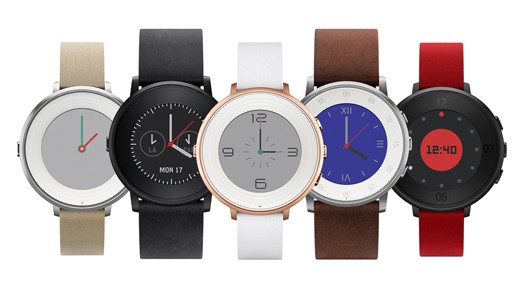A Smart Watch That Isn’t the Smartest, but Fits Small Wrists
I like the idea of a smart watch, but I still hate most of them. They try to do too much, which makes them hard to use and annoying, and they look bulky and ugly while doing it.
So I was curious to try out Pebble’s latest effort, the Pebble Time Round, which is thinner and lighter than the competition. It looks a lot like a typical wristwatch, but has a low-power, always-on, color e-paper display and a handful of clever features like the ability to show texts, e-mails, alerts, and incoming calls, and track activities. Set to be available next Tuesday, it will cost $250 to $300, depending on the watch face and band.
I recently got to test out a silver-colored one, and from the first day I wore it, I was impressed with how unobtrusive it was. The 14-millimeter leather band fit comfortably around my wrist, which mostly made up for its bland khaki hue. People who saw it didn’t even know it was a smart watch, and I quickly forgot it was, too, until it gave me a little buzz to let me know about a text or Twitter mention.
Using the watch was simple. Like other Pebble watches, it eschews a touch screen in favor of several buttons for getting around, and a vertical timeline makes it easy to see things like meetings listed on your calendar and the day’s weather forecast. Even settings are pared down to the bare necessities: for instance, you can allow all notifications (which include things like calls, texts, e-mails, and smartphone app alerts), only allow calls, or mute everything.

Notifications and calls that came in on my phone popped up promptly and discreetly on the Pebble, and I liked not being able to respond on the watch itself, for the most part (you can use a built-in microphone to send voice replies to texts if you’ve got an Android smartphone, but they won’t be on the iPhone until later this month). This made the decision of whether or not to use my phone much more deliberate than usual. Since I typically silence my phone’s ringer and alert noises, it also cut down on my normal urge to constantly check the handset’s display for missed calls or texts.
Unfortunately, the thinness of the Pebble Time Round comes at a cost: the battery lasts only about two days before needing a recharge, unlike the week or so that other Pebble watches last. That’s still double what you’ll get with many smart watches, and it charges quickly (I got it to about 90 percent in less than half an hour), but it’s annoying to regularly charge yet another gadget.
The Pebble Time’s e-paper display is also a bummer. It’s pretty dim-looking and I had to keep the backlight (accessed by a button press or an irritatingly vigorous wrist twist) on a bright setting in order to see anything on it in even moderately low light.
Furthermore, while I liked a number of the watch faces—I gravitated toward simpler ones that showed just the time and the date—only one app, a simple list-making app called Checklist, which uses the watch’s microphone to add tasks, really proved useful.
Still, the Pebble Time Round is a decent place to start if you’re looking for a smart watch that will keep you in the know without feeling too overwhelming. And for those of us with wrists that are more like twigs than tree trunks, there’s an added bonus: it actually fits.
Keep Reading
Most Popular
Large language models can do jaw-dropping things. But nobody knows exactly why.
And that's a problem. Figuring it out is one of the biggest scientific puzzles of our time and a crucial step towards controlling more powerful future models.
The problem with plug-in hybrids? Their drivers.
Plug-in hybrids are often sold as a transition to EVs, but new data from Europe shows we’re still underestimating the emissions they produce.
Google DeepMind’s new generative model makes Super Mario–like games from scratch
Genie learns how to control games by watching hours and hours of video. It could help train next-gen robots too.
How scientists traced a mysterious covid case back to six toilets
When wastewater surveillance turns into a hunt for a single infected individual, the ethics get tricky.
Stay connected
Get the latest updates from
MIT Technology Review
Discover special offers, top stories, upcoming events, and more.